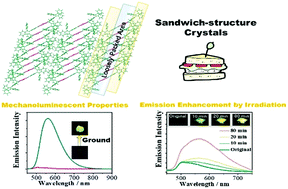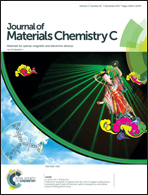Hydrogen bonding-assisted loosely packed crystals of a diaminomaleonitrile-modified tetraphenylethene compound and their photo- and mechano-responsive properties†
Abstract
In this study, loosely packed crystals with the building blocks of aggregation induced emission (AIE)-active TPE-MN molecules were constructed with the assistance of intermolecular hydrogen bonding. The AIE properties of the compound TPE-MN were studied. From single crystal analyses, a sandwich-like crystal structure with tightly packed areas (TPE moieties) and loosely packed areas was observed. Nevertheless, the TPE-MN crystals display non-emissive properties in the loosely packed crystalline state. Differential scanning calorimetry (DSC) studies, powder X-ray diffraction analyses and various photophysical studies further reveal that the loosely packed crystal structure can provide enough space for significant molecular rotations and vibrations to occur, which leads to emission quenching. By breaking the loosely packed crystal structure with mechanical force or UV irradiation, the emission band with a maximum at ca. 562 nm can be turned on. These results can serve as a basis for constructing multi-responsive materials with turn-on emissive properties.



 Please wait while we load your content...
Please wait while we load your content...